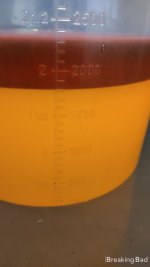- Language
- 🇺🇸
- Joined
- Jun 10, 2023
- Messages
- 128
- Reaction score
- 60
- Points
- 28
This is nothing special;
I didn't, but best would be to do closed on glas and let the fumes bubble through a PTFE hose into a strong lye or water with baking soda.
If you do that way with heating you can reheat your acid solvent to re-use.
Do not use this with stainless steel, any grade. Even with titanium it's unsuggested.
HDPE plastics for jungle methods, glass for reuses.
Keep in mind in this reaction it's the fumes that most likely do the reducing, after this reaction you must put pH 14 and then pH 7 and either vacuum destill or boil to 130 degrees and use in further reactions. If you don't use platinum with hydrogenation and the oil is clear you can generally use without vacuum.
I must mention my color is very clear with sulfuric acid which normally isn't as this clear (probably because I used then wooden stick or had to much vulcanic)
- 1KG glydicate (can also be liquid).
- 1KG of water (hotter water means less acid).
- 1.2L sulfuric acid of 98%.
I didn't, but best would be to do closed on glas and let the fumes bubble through a PTFE hose into a strong lye or water with baking soda.
If you do that way with heating you can reheat your acid solvent to re-use.
Do not use this with stainless steel, any grade. Even with titanium it's unsuggested.
HDPE plastics for jungle methods, glass for reuses.
Keep in mind in this reaction it's the fumes that most likely do the reducing, after this reaction you must put pH 14 and then pH 7 and either vacuum destill or boil to 130 degrees and use in further reactions. If you don't use platinum with hydrogenation and the oil is clear you can generally use without vacuum.
I must mention my color is very clear with sulfuric acid which normally isn't as this clear (probably because I used then wooden stick or had to much vulcanic)

